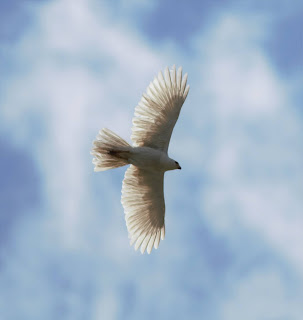Sunshine Coast Birds
Birding and other wildlife experiences from the Sunshine Coast and elsewhere in Australia - and from overseas - with scribblings about travel, environmental issues, kayaking, hiking and camping.
Sunday, 8 November 2020
Sunshine Coast Spring Sightings: Red-backed Buttonquail, Barn Swallow, Large-tailed Nightjar, Nesting Square-tailed Kite
The latest flurry of excellent sightings from the Sunshine Coast-Cooloola region in recent weeks includes Red-backed Buttonquail, Barn Swallow, Large-tailed
Nightjar, Southern Emuwren, Lewin’s Rail and nesting Square-tailed Kite.
The Red-backed Buttonquail was first spotted by Michael Dawson at the beginning of a walking trail from Landsborough to Ewen Maddock Dam. At the time of writing, it is still being seen along about 100m of trail, without seemingly moving from this small patch.
I’ve seen this species several times around the Sunshine Coast but always in tall, wet coastal grassland. The habitat at Landsborough is a narrow strip of blady grass adjoining the trail in coastal eucalypt woodland; habitat I would not have considered ideal. The remarkable thing about this bird it that it regularly leaves the blady grass to feed on the path and its edges at all the times of the day, allowing extraordinary viewing and
photographic opportunities for such a normally cryptic species. Its platelets along both sides of the track are everywhere; image of a platelet with car keys below.
The Barn Swallow was found at Rainbow Beach by Gus Daley and again, at the time of writing, the bird is still present. It perches on overhead wires in the heart of the township, roosting with Welcome Swallows and Tree Martins. The swallow’s presence is far from predictable, however. I failed on my first attempt, and it took 3.5 hours to see it the second time around. The bird appears to be actively feeding early in the morning. It comes to roost mid-to-late morning, and may stay half an hour or a couple of minutes before flying off again. Barn Swallow is very rare in south-east Queensland; this record is evidently the fourth for the region.
From Rainbow Beach I returned home via Double Island Point, photographing a Brown Noddy there, and Teewah Beach.
Barn Swallow twitches aside, I’ve spent time in the Cooloola-Tin Can Bay area. I photographed a male Southern Emuwren at Cooloola at the same spot I photographed it in 2018. While I and others often saw the species in the area in the 1970s, records have been few and far between since then, until the last few years. It is now encountered regularly but can be difficult to track down. I saw a total of 8 Eastern Ground Parrots during two visits but no sign of Brush Bronzewing.
I took the kayak up Snapper Creek in Tin Can Bay. I heard a Black Bittern but failed to see it. I did see a nice pair of Shining Flycatchers.
Large-tailed Nightjar occurs at the southern end of its extensive range on the Sunshine Coast, where it occurs at two sites: Yandina Creek Wetland and the nearby Maroochy Wetlands Sanctuary. I had tried three times to photograph calling birds before eventually snaring a rear-end photograph at the latter site just before dawn.
A pair of Square-tailed Kites is nesting in Tewantin National Park in Tinbeerwah. The species has nested in the area several times in recent years and is known to loyally stick to nesting territories, while changing nests regularly. An adult and a juvenile in advanced plumage were around the nest during my visit. Other observers have reported an active nest in Koala Park, Nambour.
I’d heard Lewin’s Rail several times this year but managed photographs just recently after the first heavy rains of the season. A bird at Peregian Beach showed very nicely indeed.
Other good birds in the area included White-winged Triller at Parklakes. The count continues for the 2020 BirdLife Australia Sunshine Coast photographic competition. My tally stands at 305 species photographed with images of three others – Bridled Tern, Red-chested Buttonquail and King Quail – not making the grade.
Amongst the flurry of feathers has been a house move from our home of 11.5 years at Ninderry to another home in the hills on the western fringe of Nambour, overlooking the town and surrounding valleys. A white phase Grey Goshawk flew overhead on our last day at Ninderry.
It’s good to see old friends again at the new diggings, with White-headed Pigeons quickly taking their place at the relocated feeder.
Subscribe to:
Post Comments (Atom)
















Excellent!
ReplyDeleteAs always .. love your Sunshine Coast Blog Greg.
ReplyDelete